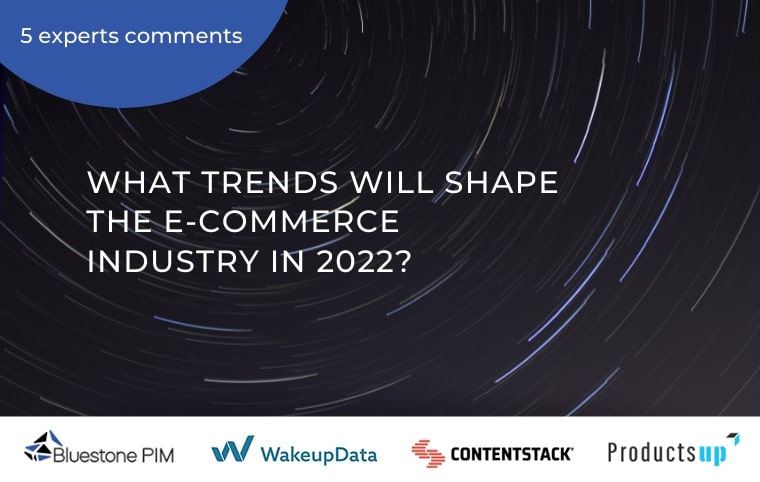
The e-commerce industry is rapidly evolving as online shoppers change their behavior and technology trends are implemented. The pandemic was a turning point and fueled the industry’s growth. In 2021, retail e-commerce sales amounted to approximately 4.9 trillion U.S. dollars worldwide and it is forecast to grow and reach about 7.4 trillion dollars by 2025.
Today, eCommerce brands face many challenges such as enhancing customer experience, agility, or customer retention. E-commerce trends can be the answer and a guideline that brands should follow to meet exploding customer expectations.
The year 2021 was marked by the rise of eCommerce trends such as quick commerce with lightning-fast deliveries, or Buy Now, Pay Later.
What will happen in the world of online shopping in 2022 and what emerging trends will drive online sales? We’ve asked leading SaaS solution providers that support eCommerce businesses of all sizes. Find out what experts from Bluestone PIM, Contentstack, WakeUpData, and Productsup predict.
- Composable Commerce
- The Metaverse
- Omnichannel Strategy and New Ways to Implement It Faster
- Google LIA as Part of Your Omnichannel Strategy
- Social Commerce
Composable Commerce
Morten Næss | EVP Technology at Bluestone PIM
In my opinion, one of the most important trends in e-commerce will be openness, flexibility, and modularity in one approach. Composable commerce is becoming increasingly important because it allows companies to combine and customize various best-of-breed components into a single solution tailored to their specific business needs.
When developing their tech stack, many enterprises and software houses are turning to architectures based on the principles of MACH (stands for Microservices, API-first, Cloud-native, and Headless) to become more agile and future-proof. According to a DJS Research survey commissioned by MACH Alliance, 81% of technical decision-makers surveyed expressed a strong intention to increase MACH elements in their front-office architecture over the next 1-2 years.
Moving away from monolithic structures to MACH opens up endless possibilities and opportunities to keep up with rapidly changing technologies and markets, and this is crucial for e-commerce companies to stay competitive.
The Metaverse
Jasmin Guthmann | Senior Director for Global Partner Marketing at Contentstack
The metaverse has become one of the most talked-about trends in the second half of 2021 and with good reason – when Facebook rebranded, it sent a very clear signal that the metaverse was likely to become the next iteration of how people and technology interact. This has many implications but one of the most profound is how people will consume and interact with content – and therefore consume and interact with brands.
The metaverse lives by blurred lines – it is born of an incredible mix of social, mobile, gaming, and crypto, with a dash of VR for good measure. It puts people at the heart of every experience and is dominated by issues of play, community, and value creation. Content in the metaverse must reflect that.
For a lot of businesses, this is incredibly scary – the foundational elements of B2B and B2C, fade away and traditional ideas of market segmentation or target demographics are thrown out of the window. But this is also very exciting as brands can generate awareness of products and services in new ways and test themselves in new and unexplored audiences.
A successful strategy for this begins with personalization. Metaverse leaders will need to be ultra-specific about targeting a given experience– in terms of who, where, when, and why. Aligning a brand with a series of these temporary experiences that build in the metaverse will then make products and services more rewarding and meaningful to consumers. These experiences may be both small and numerous, so managing them at scale will itself become quite an undertaking, but it will mark metaverse leaders quite early on.
Omnichannel Strategy and New Ways to Implement It Faster
Borgar Hestad | EVP Sales & Marketing at Bluestone PIM
Omnichannel stays strong, driving retail growth and evolving. In B2B sales, omnichannel is more effective and consumers are using more channels than ever before. According to McKinsey’s research, in the U.S., the number of distinct channels customers use during their decision journey has increased from 5 in 2016 to 10 in 2021. E-commerce companies must implement innovation to handle the growing number of channels and touchpoints and deliver the personalization so highly expected by today’s customers.
We see a new trend in the market where large retailers are seeking to improve their omnichannel efforts by looking at how their commerce architecture can become more composable. They want to be more agile, reducing project implementation time by selecting best-of-breed applications and making changes as they go. They have experienced that best-of-suite models do not support their business and the risk is too high to undertake large, expensive implementation projects with uncertain output gains. Our clients and prospects seem to be looking more into MACH-based architecture and making investments accordingly.
Google LIA as Part of Your Omnichannel Strategy
iEva Lauridsen | CEO at WakeupData
If you have already decided to look into omnichannel in 2022, Google Local Inventory Ads (LIA) should be at the top of your list. Being able to show potential customers that you have the products in stock where and when they need them is a great starting point for bringing more sales to your store. The user can either buy online and pick up in your store, buy online and “Pickup later” or visit your store to get the product, with the chance of buying something else.
Early adopters of Google LIA are seeing impressive results – one Norwegian retailer saw an impressive 142% increase in-store visits using Google LIA over normal Google Shopping.
If you have multiple physical stores it can be daunting to get the infrastructure in place, updating your feeds with stock levels in each store, but a good feed management platform with experienced experts can guide you all the way and get you set up for success. First movers on Google LIA are seeing great results as their ads move ahead of the competition at lower costs.
Social Commerce
Saskia Van De Ven | Senior Vice President, Partners at Productsup
Social commerce may seem like a fairly obvious trend considering all of the major social media platforms continue to add shopping capabilities. However, less than 25% of companies sell their products on the world’s largest social commerce platforms. This is a missed opportunity for brands and retailers as consumers are increasingly using new and diverse channels to discover products, interact with brands, and ultimately, complete purchases.
From influencer marketing to live stream shopping, social commerce presents a significant opportunity for companies to reach younger generations and deliver content that builds long-term customer relationships. But managing product data across various social media accounts on multiple platforms across different markets is an exceptionally complex process.
Product touch points need to be authentic and personalized across every social commerce channel, while also delivering consistent and accurate product information. We’re seeing more and more companies look to product-to-consumer (P2C) management to better control their social commerce presence.
Looking for a long-term growth strategy? Find out how to future-proof your e-commerce business using modern technology and investing in a talent pool.
Tags
E-commerce Tips 2022 COMPOSABLE COMMERCE metaverse omnichannel social commerce trends e-commerceYou might also like

eCommerce in 2025: Hot Trends Predicted by Experts

2019 Our Picks on Bluestone Blog



